
Sir Kenneth Clark’s ‘Civilisation’: Part IV
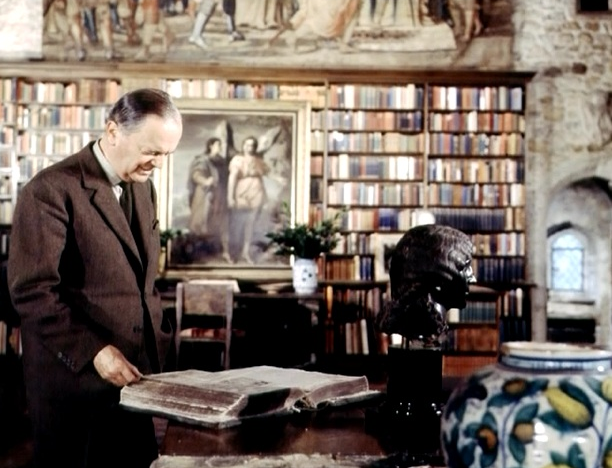
This week we visit an era that was very precious to Clark. He explores the emergence of Humanism and the beginning of the Renaissance, two of the most remarkable events in the history of Western thought. Visiting Florence, Clark argues that European thought gained a new impetus from its rediscovery of its classical past in the 15th century. He also visits the palaces at Urbino and Mantua and other centres of Renaissance civilisation.
The Florentine Renaissance
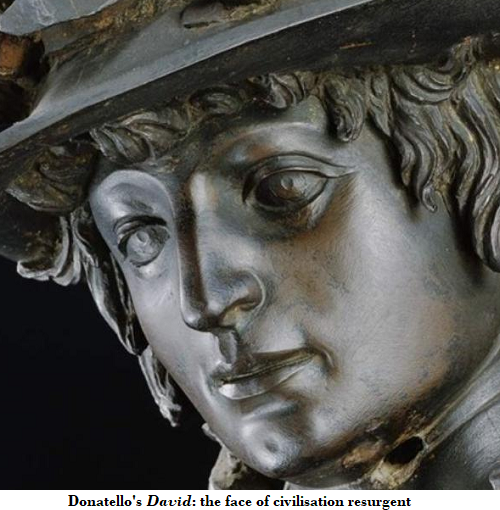
Florence was a republic and was about business, as any visit there will still make clear. As Clark says, “the men who made Florence the richest city in Europe, the bankers and wool-merchants, the pious realists.” They had built their success on trade, banking, wool and the textile industry, in which thousands laboured in grim conditions to support the city’s wealthy elite. The civic leaders knew they lived in a violent, harsh, and unforgiving world, riddled with class antagonism, business rivalry, political factionalism and personal vendettas. Consequently, they “lived in grim defensive houses strong enough to withstand party feuds and popular resentment.”
The Measure of All Things: And yet out of this unpromising urban and commercial context emerged “the extraordinary episode in the history of civilisation known as the Renaissance.” “What had happened?” Clark asks, and claims the answer lies in one sentence by Protagoras:
“Man is the measure of all things.”
This has been taken to mean that all things are relative. However, it has more to do with the place of human beings in the world. It involves recognition of humanity’s unique place in the cosmos, and a reassertion of the principal that things should be made to reflect that status.
Hymns to the Divine Light: This is seen best in the architecture of the Renaissance. As Clark later observes “people sometimes feel disappointed the first time they see” some of its most important early works, precisely because “they seem so small [especially] after the great monuments of Romanesque and Gothic architecture.” This is a natural reaction because the earlier works expressed a monumental vision of divinity, in comparison with which individual people must feel like ants. The great cathedrals served “to impress us or crush us by size and weight, as all God-directed architecture does.” Renaissance architecture was a reaction to this. As Clark concludes as he visits some Florentine cloisters
The Gothic cathedrals were hymns to the divine light. These cloisters happily celebrate the light of human intelligence, and sitting in them I find it quite easy to believe in man.
Human Dignity: The Renaissance was also a reaffirmation of human dignity, a defiant reaction against the remorseless forces that had driven human beings down and made them feel of little value, sinful vermin or refuse. After all, this period began only half a century after the Black Death had brought death to nearly half the population of Europe, with tens of millions of pitiful dead littering the streets across the continent.
‘Like an Immortal God’: This reaffirmation found expression in the words of the architect Leon Battista Alberti, quoted by Clark,
To you is given a body more graceful than other animals, to you power of apt and various movements, to you most sharp and delicate senses, to you wit, reason, memory like an immortal god.
This brought a Reformation counter-reaction, as Clark discusses in Episode 6.
Founding Fathers: But there was a realism mixed with this idealism. The Florentines were anything but naïve and this is reflected in paintings of them. Clark cites a series of frescoes of civic leaders by Masaccio:
What characters they are: morally and intellectually men of weight, the least frivolous of men [with] the air of contained vitality and confidence that one often sees in the founding fathers of a civilisation.
Dwarves to Giants: Clark emphasizes one of his key ideas about civilisation:
There is no better instance of how a burst of civilisation depends on confidence than the Florentine state of mind in the early 15th century.
Instead of seeing themselves as their medieval forebears had, as “dwarves standing on the shoulders of giants,” Florentine leaders like Coluccio Salutati and Leonardo Bruni compared themselves with the titans of Classical Greece and Rome, a great civilization they fancied was an alter ego of th eir own, and whose heritage they set out to retrieve and emulate in politics and the arts.
eir own, and whose heritage they set out to retrieve and emulate in politics and the arts.
Petrarch and the Scholars: Such men prided themselves as Humanist scholars (see Appendix), inspired by Petrarch (left), the first great intellectual. A major love poet, Petrarch was an extremely introspection and reflective individual who pursued rare Classical texts across Europe while torturing himself over his ignorance of Greek, holding a copy of Homer in the original against his forehead and sobbing that “it must be so beautiful, if only I could read it.” He is said to have been the first man to climb a major mountain and enjoy the view purely for pleasure. Those who followed him in the pursuit of Classical learning knew Greek and developed sophisticated methods of textual analysis that revolutionized scholarship.
Heroes of Scholarship: Their greatest pride were the ancient texts that they had recovered and that opened wide a window into the revered Classical Age.
In Florence the first 30 years of the 15th century were the heroic age of scholarship when new texts were discovered and old texts edited, when scholars were teachers and rulers and moral lea ders.
ders.
In art, the heroes of scholarship were “usually represented as one of the Church fathers.” These saints were pursuing the truth of God, but “the Renaissance scholar searching for truth in Classical texts was scarcely less intense.”
Explosion of Mind: Where the Gothic cathedrals were hymns to divine light, the libraries and cloisters of Florence “celebrated the light of human intelligence.” They were centres of learning where careful scholarship “could alter the course of history with an explosion … of mind.”
Vitruvian Man: The re-location of the human individual and human scale to the centre of things found expression in many ways. One is the famous Vitruvian Man, a drawing by Leonardo da Vinci (at left) ostensibly based on the correlations of ideal human proportions with geometric principles described by the ancient Roman architect Vitruvius. The human body is presented as a microcosm of the universe, with which it shares fundamental mathematical rules of proportion: therefore, ideal human beauty reflects the fundamental structure of the universe. As Clark observes, it also reflects the arcane metaphysical notion that “through proportion we can reconcile the two parts of our being, the physical and the intellectual.”
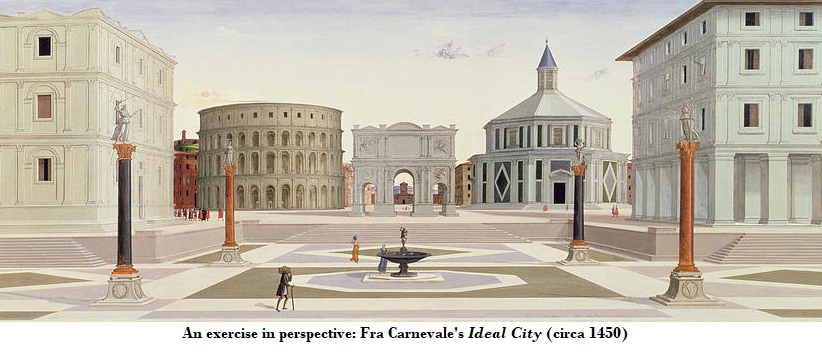
Perspective: An even more powerful tool derived from mathematics and geometry was the application of the principles of perspective to painting (above) and relief sculpture by artists including Filippo Brunelleschi, Masaccio, Paolo Uccello, and Piero della Francesca. Via this technique it became possible to render on a flat surface the precise position of a figure or object in notional three-dimensional space, conveying a convincing sense of depth and relationality. The world came to be represented as seen from the viewpoint of the human eye, and this came to be a presumption about the nature of things (compared, e.g., with a fisheye view of the world). Artistically, this presumption was undermined in the 20th century with the advent of Cubism and other styles.
Perspective and Civilisation: Perspective was particularly suited to an urban environment like Florence, and Clark believes it made a major contribution to civilisation as it became widely applied in the 15th century:
the belief that one could represent a man in a real setting and calculate his position and arrange figures in a demonstrably harmonious order, expressed symbolically a new idea about man’s place in the scheme of things and man’s control over his own destiny.
Competition & Criticism: Clark notes also the vital role played in the civilisation of the Renaissance by the competitive nature of proud and ambitious artists and their sponsors, along with the spirit of criticism. He quotes the founder of art history, Giorgio Vasari:
the spirit of criticism: the air of Florence making minds naturally free, and not content with mediocrity.
Beauty and Realism: Above all, there was a love of beauty, and Clark points out various works that exemplify the crucial role played by the pursuit of beauty and how well it was achieved, especially by Donatell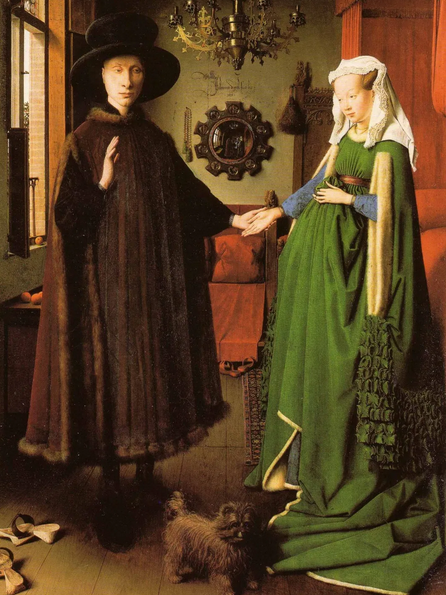 o with, e.g., his lithesome David. On the other hand, there was a movement away from portraits that merely idealised the subject and towards ones that sought to portray them realistically, “proud Florentines who wanted to record for posterity exactly what they were like.”
o with, e.g., his lithesome David. On the other hand, there was a movement away from portraits that merely idealised the subject and towards ones that sought to portray them realistically, “proud Florentines who wanted to record for posterity exactly what they were like.”
Jan van Eyck As an aside, Clark points out that this realism was pioneered by the Flemish artists in what came to be known as the Northern Renaissance. He cites the remarkable Arnolfini and his wife by Jan van Eyck (left).
Lorenzo’s Florence From the middle of the 15th century Florence came to be dominated by Lorenzo de Medici, and under him and his cousin Lorenzino the arts and literature flourished. This was exemplified by Sandro Botticelli’s great paintings, Primavera, the Allegory of Spring (below), and Birth of Venus. These in turn were influenced by the mystical theosophy of Neoplatonism that inspired Florentine intellectuals. They aimed to reconcile this with Christianity as expressions of the philosophia perennis.

The Perennial Philosophy: Florentine Neoplatonists, including Marsilio Ficino and Giovanni Pico della Mirandola, believed that there was one great philosophia perennis that underlies and unifies all religions and metaphysical systems. They believed this has existed since primordial times but has been suppressed and forgotten. Their mission was to retrieve this esoteric Truth and re-unite the mystical traditions of Christianity, Islam, Neo-Platonism, the Kabballah, and Hermeticism into one universal system that could be the basis for worldwide harmony. This quest continues.
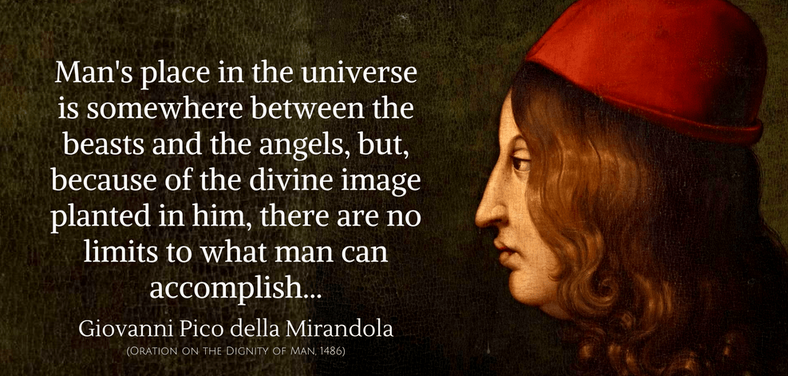
Urbino: Clark takes us to Urbino, a little city in the rugged Apennines, where the court of Duke Federigo Montefeltro “was one of the high-water marks of western civilisation.” He finds there a unique open, calm, and airy style, and a palace permeated by the Duke’s own humanity and civility.
Renown: Urbino (below)was a place where young noblemen were sent to finish their educations and learn the niceties of civilised behaviour, an art recorded in Baldassare Castiglione’s famous book, The Courtier. Clark points out that Raphael used to visit the court as a child, and so
one of the civilising forces of the western imagination found his earliest impressions of harmony and proportion and good manners in the court of Urbino.
Clark finds similar civilising forces in Mantua and Ferrara.
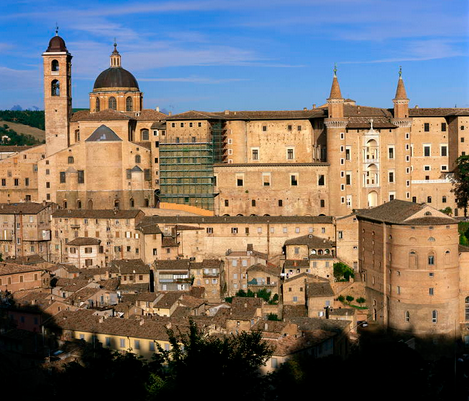
Elites and Masses: Clark observes that the civilised nature of such cities and courts depended upon the nature of the ruler at the time, and concedes that it was “one of the weaknesses of Renaissance civilisation … that it depended on a very small minority.” From this two points arise: (1) It is often through the wilful dynamism of individuals or elites that civilising breakthroughs occur; and (2) It remains unclear whether there is any ‘civilisation of the masses’, unrecorded by history. At the very least, Clark observes, the common folk bring order to the chaos of the rustic countryside, and “bringing order out of chaos is a process of civilisation.”

Landscapes: This raises the question of the origins of landscape painting, which Clark identifies in the background of van Eyck’s Adoration of the Lamb (above). He also cites Giorgione, “one of the inspired, unpredictable innovators who disturb the course of history,” with such works as Fête Champêtre with its naked ladies (below) entertained by minstrels against a rustic background. He sees this as a tribute to the pagan myth of arcadia that signals “the rediscovery of man in his sensual rather than his intellectual nature.”
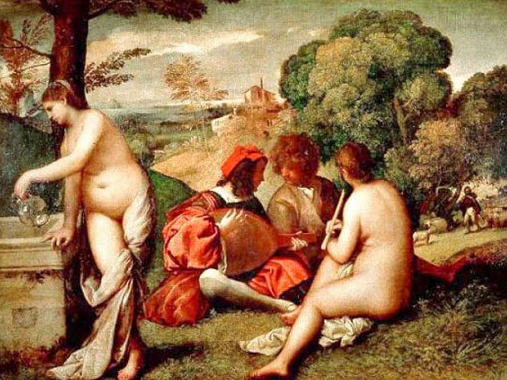
Tempesta and Pessimism: Clark also invokes Giorgione’s mysterious Tempesta, often regarded as the first great landscape. He asks (understandably) “what on earth is going on?” Nobody has ever known, he concedes, but whatever the picture means, “it certainly doesn’t show any confidence in the light of human reason.” This leads Clark to reflect on the limitations of the early Renaissance vision that ‘Man was the measure of all things’. He recalls Alberti’s claim that “a man can do all things if he will,” and laments that this ignores
that great bundle of fears and memories that every individual carries around within him, to say nothing of the external forces which are totally beyond his control.
He believes that Giorgione heralded “the new pessimism” that found its most articulate expression in Hamlet, as he discusses in a later episode.
Reaction: These pessimistic reflections lead Clark to conclude that
the truth is that the civilisation of the early Italian Renaissance was not broadly based enough. The few had gone too far away from the many, not only in knowledge and intelligence, but in basic assumptions.
Consequently, as we will see in Week 6,
when the first two generations of humanists were dead their movement had no real weight behind it, and there was a reaction away from the human scale of values.
However, the work of these great Renaissance artists has left behind “a message to every generation that values reason, clarity and harmonious proportion, and believes in the individual.”
Onwards! Despite these observations, Clark is not at all finished with the Renaissance, but has much more to say, especially about its undoubted masters, as we will see next week.
APPENDIX: HUMANISM
Origins: Humanism was at the core of the Renaissance. It was a massive cultural movement initiated by lay scholarship reflecting the interests of the newly emerging middle-classes produced by improved trade, commerce, and industry. It focused on the Classics – the art, literature, and history of Greece and Rome, and their contemporary application. Although not anti-Christian, the Humanists saw themselves following an alternative intellectual path to that offered by the Church, which was widely perceived as intellectually backward and morally decadent.
Petrarch: Historically, Francesco Petrarca (1304-74) is generally regarded as the father of Humanism. He coined the term, ‘the Dark Ages’ to refer to the centuries after the Fall of Rome, which he considered shrouded in darkness after the ‘light’ of classical antiquity. A brilliant but rootless intellectual, Petrarch began reflecting on the self and human potentiality and the ‘this-worldly’ meaning of life, and believed scholars could draw upon the cultural treasures of Classical Civilization while still pursuing an authentic relationship with God.
Back to the Sources: The key principle of Humanist scholarship was the Latin expression ‘ad fontes’ (‘back to the sources’; lit. ‘to the fountains’). This refers to the conviction that sound knowledge and argumentation depends on mastery of the earliest and most fundamental sources upon which knowledge is based. It was epitomized by the great enthusiasm of the Humanists for the rigorous study of Greek and Latin literature.
Educational Program: Humanism was based on the belief that a virtuous life could be achieved through education. As Oscar Kristeller (Renaissance Thought, 1961, p.10) stresses, “Renaissance humanism was not [primarily] a philosophical tendency or system, but rather a cultural and educational program that emphasized and developed the studia humanitatis”, from which the name ‘Humanism’ is derived.
The Studia Humanitatis: Humanists stressed the studia humanitatis, the seven intellectual disciplines considered essential for free citizens if they were to participate virtuously in civic life. These consisted of the Trivium and Quadrivium:
- Trivium In Classical antiquity there were three disciplines considered essential – grammar, rhetoric, and logic. These are concerned with the realm of mind.
- Quadrivium In the Middle Ages a further four were added – arithmetic, geometry, music, and astronomy. These are concerned with the realm of matter and space.
The studia humanitatis constituted an educational program aimed not just at the mere transmission of knowledge but at the perfection of personal virtue through scholarship.
The Humanist World-View: Overall, the Humanists:
# Stressed the study of the Classics as the portal into knowledge and virtue.
# Emphasized the individual human journey in this life rather than a pre-occupation with the next life, and stressed the privileged place humanity occupies in the universe.
# Deplored the mental shackles imposed by religious orthodoxy and scholastic philosophy, possessed a renewed confidence in free human thought and creativity, and placed a high value on reason and the pursuit of truth wherever it led.
# Tended to emphasize humanity’s inherent goodness instead of humanity’s sinfulness.
# Focused on the discovery and transformation of the self. As Kristeller (1961, 20) observes, Humanism was driven by a fundamental “tendency to express … the concrete uniqueness of one’s feelings, opinions, experiences, and surroundings”. Consequently, letters, memoirs, confessions, and biographies became popular genres.
# Believed in the unity of knowledge produced by all philosophical and theological schools and systems, and tried to promote a consolidated spiritual, intellectual, and aesthetic outlook.
Madam: Archbishop Fisher (July-August 2024) does not resist the attacks on his church by the political, social or scientific atheists and those who insist on not being told what to do.
Aug 29 2024
6 mins
To claim Aborigines have the world's oldest continuous culture is to misunderstand the meaning of culture, which continuously changes over time and location. For a culture not to change over time would be a reproach and certainly not a cause for celebration, for it would indicate that there had been no capacity to adapt. Clearly this has not been the case
Aug 20 2024
23 mins
A friend and longtime supporter of Quadrant, Clive James sent us a poem in 2010, which we published in our December issue. Like the Taronga Park Aquarium he recalls in its 'mocked-up sandstone cave' it's not to be forgotten
Aug 16 2024
2 mins







